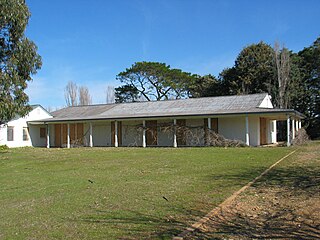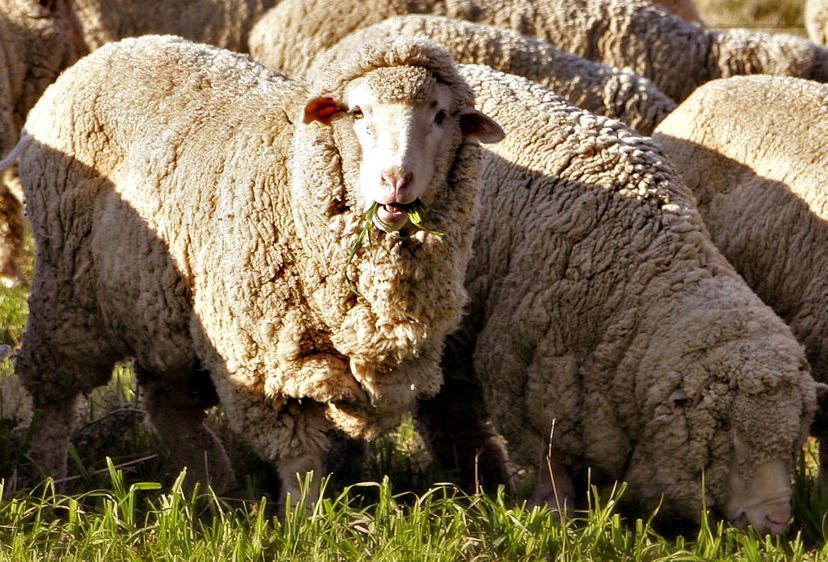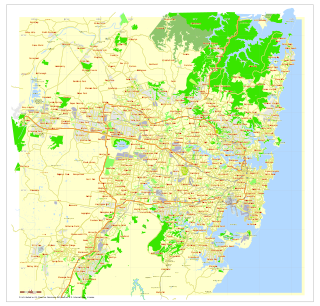
Wool is the textile fiber obtained from sheep and other animals, including cashmere and mohair from goats, qiviut from muskoxen, from hide and fur clothing from bison, angora from rabbits, and other types of wool from camelids; additionally, the Highland and the Mangalica breeds of cattle and swine, respectively, possess wooly coats. Wool consists of protein together with a few percent lipids. In this regard it is chemically quite distinct from the more dominant textile, cotton, which is mainly cellulose.

Queanbeyan is a city in south-eastern region of the Australian state of New South Wales, located adjacent to the Australian Capital Territory in the Southern Tablelands region. Located on the Queanbeyan River, the city is the council seat of the Queanbeyan-Palerang Regional Council. At the 2016 census, the Queanbeyan part of the Canberra–Queanbeyan built-up area had a population of 36,348.

Sheep shearing is the process by which the woollen fleece of a sheep is cut off. The person who removes the sheep's wool is called a shearer. Typically each adult sheep is shorn once each year. The annual shearing most often occurs in a shearing shed, a facility especially designed to process often hundreds and sometimes more than 3,000 sheep per day.

The Queanbeyan Age is a weekly newspaper based in Queanbeyan, New South Wales, Australia. It has had a number of title changes throughout its publication history. First published on 15 September 1860 by John Gale and his brother, Peter Francis Gale, The Golden Age, as it was known at the time, was the first newspaper of the small township on the banks of the Queanbeyan River. It was named due to the short-lived Kiandra goldrush, which generated large amounts of gold-based traffic through the region.

The Queanbeyan River, a perennial stream that is part of the Molonglo catchment within the Murray–Darling basin, is located in the Monaro and Capital Country regions of New South Wales and the Australian Capital Territory, in Australia. The river is 104 kilometres (65 mi) in length with a catchment area of 96,000 hectares. The Queanbeyan River and the Cotter River meet the potable water supply needs of the Canberra and Queanbeyan region and whose water quality is specifically protected under Federal legislation.

Flynn is a suburb in the Belconnen district of Canberra, located within the Australian Capital Territory, Australia.

Lawson is a suburb in the Belconnen district of Canberra, located within the Australian Capital Territory, Australia. The suburb is surrounded by Baldwin Drive, William Slim Drive and Ginninderra Drive. It lies next to the suburbs of McKellar, Giralang, Kaleen, Bruce and Belconnen.
The history of the Australian Capital Territory (ACT) as a separate administrative division began in 1911, when it was transferred from New South Wales to the Australian federal government. The territory contains Australia's capital city Canberra and various smaller settlements. Until 1989, it also administered the Jervis Bay Territory, a small coastal region.

John Gale was an Australian newspaper proprietor, lay preacher and politician. He was the founder of The Queanbeyan Age, the first newspaper to serve the Queanbeyan district in New South Wales. He was also an advocate for the Queanbeyan-Canberra area as the best site of a future Australian national capital, for which he is sometimes called the "Father of Canberra". He served a single term as Member for Murrumbidgee in the New South Wales Legislative Assembly.

Samuel Shumack was an early Canberra pioneer and Australian farmer. He wrote his autobiography in the 1920s and it was published in 1967 as an account of rural living in the Canberra district.
The Royal Canberra Show is an agricultural show that has been staged annually in Canberra since 1927 by the Royal National Capital Agricultural Society. The show has agriculture at its core, but it has expanded with the addition of rides, competitions and educational facilities. It is said that this is where "city meets country" and "country meets city".

Gold Creek Homestead (1) is a 140-year-old stone and brick building located off Gungahlin Drive in Ngunnawal a north-western suburb of Canberra, Australia. It is adjacent to the Grove Ngunnawal retirement village currently being developed by Lend Lease.
Cuppacumbalong is an historic homestead located near the southern outskirts of Canberra in the Australian Capital Territory. It is also the name of a former 4,000-acre (16 km2) sheep and cattle grazing property that surrounded the homestead near the junction of the Murrumbidgee and Gudgenby Rivers. The word Cuppacumbalong is Aboriginal in origin and means 'meeting of the waters'. One of the property's early owners Leopold Fabius Dietegen Fane De Salis made a noteworthy contribution to political life during colonial times and furthermore, Cuppacumbalong has strong connections to the life of William Farrer, the father of the Australian wheat industry.
Queanbeyan District Cricket Club is a cricket club operating in the Queanbeyan district of New South Wales and playing in the Australian Capital Territory (ACT) cricket competition. It was formally founded in 1863.
George Gribble (1868–1947) was an Australian farmer and soldier, who won renown in tent pegging and other sports.
John Casey was an Irish rebel, who was caught and tried in 1824 and transported to Australia in 1826. He won his freedom by helping capture the bushranger, John Tennant, in 1828 and became one of the early pioneers of the Gundaroo district.
Laurence Frederic Fitzhardinge was an Australian historian and librarian. He was known as a pioneer of the Australian Dictionary of Biography, and also as the official biographer of Billy Hughes.


















